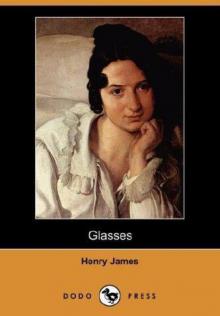- Home
- Henry James
Travels With Henry James Page 16
Travels With Henry James Read online
Page 16
Of the smaller cathedrals of Italy, I know none that I prefer to that of Pisa; none which, on a moderate scale, produces more the impression of a great church. Indeed, it seems externally of such moderate size that one is surprised at its grandeur of effect within. An architect of genius, for all that he works with colossal blocks and cumbrous pillars, is certainly the most cunning of all artists. The façade of the cathedral of Pisa is a small pyramidal screen, covered with delicate carvings and chasings, distributed over a series of short columns upholding narrow arches. It looks like an imitation of goldsmith’s work in stone, and the space covered is apparently so small that there seems a fitness in the dainty labor. How it is that on the inner side of this façade the wall should appear to rise to a splendid height, and to support one end of a ceiling as remote in its gilded grandeur, one could almost fancy, as that of St. Peter’s; how it is that the nave should stretch away in such solemn vastness, the shallow transepts carry out the grand impression, and the apse of the choir hollow itself out like a dusky cavern fretted with golden stalactites—all this must be expounded by a keener architectural analyst than I. To sit somewhere against a pillar, where the vista is large and the incidents cluster richly, and vaguely resolve these mysteries without answering them, is the best of one’s usual enjoyment of a great church. It takes no great ingenuity to conjecture that a gigantic Byzantine Christ, in mosaic, on the concave roof of the choir, contributes largely to the impressiveness of the place. It has even more of stiff solemnity than is common to works of its school, and it made me wonder more than ever what the human mind could have been when such unlovely forms could satisfy its conception of holiness. There seems something truly pathetic in the fate of these huge mosaic idols, and in the change that has befallen our manner of acceptance of them. It is a singular contrast between the original sublimity of their pretensions and the way in which they flatter that audacious sense of the grotesque which the modern imagination has smuggled even into the appreciation of religious forms. They were meant to be hardly less grand than the Deity itself, but the only part they play now is to mark the further end of our progress in spiritual refinement. The two limits, on this line, are admirably represented in the choir at Pisa, by the flat gilded Christ on the roof and the beautiful specimen of the painter Sodoma on the wall. The latter, a small picture of the Sacrifice of Isaac, is one of the best examples of its exquisite author, and perhaps, as chance has it, the most perfect opposition that could be found to the spirit of the great mosaic. There are many painters more powerful than Sodoma—painters who, like the author of the mosaic, attempted and compassed grandeur; but none possess a more persuasive grace, none more than he have sifted and chastened their conception till it exhales the sweetness of a perfectly distilled perfume.
Of the patient successive efforts of painting to arrive at the supreme refinement of Sodoma, the Campo Santo hard by offers a most interesting memorial. It presents a long, blank marble wall to the relative profaneness of the cathedral close, but within it is a perfect treasure-house of art. A long quadrangle surrounds an open court, where weeds and wild-roses are tangled together, and a sunny stillness seems to rest consentingly, as if nature had been won to consciousness of the precious relics committed to her. Something in the place reminded me of the collegiate cloisters of Oxford; but it must be confessed that this is a handsome compliment to Oxford. The open arches of the quadrangles of Magdalen and Christ Church are not of mellow Carrara marble, nor do their columns, slim and elegant, seem to frame the unglazed windows of a cathedral. To be buried in the Campo Santo of Pisa you need only be illustrious, and there is liberal allowance both as to the character and degree of your fame. The most obtrusive object in one of the long vistas is a most complicated monument to Madame Catalani, the singer, recently erected by her (possibly) too appreciative heirs. The wide pavement is a mosaic of sepulchral slabs, and the walls, below the base of the paling frescoes, are encrusted with inscriptions and encumbered with urns and antique sarcophagi. The place is at once a cemetery and a museum, and its especial charm is its strange mixture of the active and the passive, of art and rest, of life and death. Originally its walls were one vast continuity of closely-pressed frescoes, but now the great capricious scars and stains have come to outnumber the pictures, and the cemetery has grown to be a burial-place of pulverized masterpieces as well as of finished lives. The fragments of painting that remain are, however, fortunately the best; for one is safe in believing that a host of undimmed neighbors would distract but little from the two great works of Orcagna. Most people know the “Triumph of Death” and the “Last Judgment” from descriptions and engravings; but to measure the possible good faith of imitative art, one must stand there and see the painter’s howling potentates dragged into hell in all the vividness of his bright, hard coloring; see his feudal courtiers on their palfreys, holding their noses at what they are so fast coming to; see his great Christ, in judgment, deny forgiveness with a gesture commanding enough to extinguish the idea. The charge that Michael Angelo borrowed his cursing Saviour from this great figure of Orcagna is more valid than most accusations of plagiarism; but of the two figures one at least could be spared. For direct, triumphant expressiveness these two superb frescoes have probably never been surpassed. The painter aims at no very delicate meanings, but he drives certain gross ones home so effectively that for a parallel to his skill one must look to the stage.
On the other side of the cloister one finds the beautiful frescoes of Benozzo Gozzoli. If Orcagna’s work was elected to survive the ravages of time, it is a happy chance that it should be balanced by a group of performances of such a different temper. The contrast is the more striking that, in subject, the work of both painters is narrowly theological. But Benozzo cares in his theology for nothing but the story, the scene, and the drama—the chance to pile up palaces and spires in his backgrounds against pale-blue skies cross-barred with pearly, fleecy clouds, and to scatter sculptured arches and shady trellises over the front, with every incident of human life going forward lightly and gracefully beneath them. Lightness and grace are the painter’s great qualities; and, if we had to characterize him briefly, we might say that he marks the hithermost limit of unconscious elegance. His charm is natural fineness; a little more, and we should have refinement—which is a very different thing. Like all les délicats of this world, as M. Renan calls them, Bonozzo has suffered greatly. The space on the walls he originally covered with his Old Testament stories is immense; but his exquisite handiwork has peeled off by the acre, as one may almost say, and the latter compartments of the series are swallowed up in huge white scars, out of which a helpless head or hand peeps forth, like those of creatures sinking into a quicksand. As for Pisa at large, although it is not exactly what one would call a mouldering city—for it has a certain well-aired cleanness and brightness, even in its supreme tranquillity—it affects the imagination in very much the same way as the Campo Santo. And, in truth, a city so ancient and deeply historic as Pisa is at every step but the burial-ground of a larger life than its present one. The wide, empty streets, the gaudy Tuscan palaces (which look as if about all of them there were a genteel private understanding, independent of placards, that they are to be let extremely cheap), the delicious relaxing air, the full-flowing yellow river, the lounging Pisani smelling, metaphorically, their poppy-flowers, seemed to me all so many admonitions to resignation and oblivion. And this is what I mean by saying that the charm of Pisa (apart from its cluster of monuments) is a charm of a high order. The architecture is not especially curious; the lions are few; there are no fixed points for stopping and gaping. And yet the impression is profound; the charm is a moral charm. If I were ever to be incurably disappointed in life; if I had lost my health, my money, or my friends; if I were resigned, for evermore, to pitching my expectations in a minor key, I think I should go and live at Pisa. Something in the atmosphere would assent most soothingly to my mind. Its quietude would seem something more than a stillness—a hush. Pisa may b
e a dull place to live in, but it is a capital place to wait for death.
Nothing could be more charming than the country between Pisa and Lucca—unless possibly it is the country between Lucca and Pistoia. If Pisa is dead Tuscany, Lucca is Tuscany still living and enjoying, desiring and intending. The town is a charming mixture of antique picturesqueness and modern animation; and not only the town, but the country—the blooming, romantic country which you behold from the famous promenade on the city-wall. The wall is of superbly solid brickwork and of extraordinary breadth, and its summit, planted with goodly trees, and swelling here and there into bastions and little open gardens, surrounds the city with a circular lounging-place of extreme picturesqueness. This well-kept, shady, ivy-grown rampart reminded me of certain mossy corners of England; but it looks away to a prospect of more than English loveliness—a broad, green plain, where the summer yields a double crop of grain, and a circle of bright blue mountains speckled with high-hung convents and profiled castles and nestling villas, and traversed by valleys of a deeper and duskier blue. In one of the deepest and shadiest of these valleys a charming watering-place is hidden away yet awhile longer from railways, the baths to which Lucca has given its name. Lucca is pre-eminently a city of churches, ecclesiastical architecture being, indeed, the only one of the arts to which it seems to have given attention. There are picturesque bits of domestic architecture, but no great palaces, and no importunate frequency of pictures. The cathedral, however, is a résumé of the merits of its companions, and is a singularly noble and interesting church. Its peculiar boast is a wonderful inlaid front, on which horses and hounds and hunted beasts are lavishly figured in black marble over a white ground. What I chiefly enjoyed in the gray solemnity of the nave and transepts was the superb effect of certain second-story Gothic arches (those which rest on the pavement are Lombard). These arches are delicate and slender, like those of the cloister at Pisa, and they play their part in the dusky upper air with real sublimity.
At Pistoia there is, of course, a cathedral, and there is nothing unexpected in its being, externally at least, a very picturesque one; in its having a grand campanile at its door, a gaudy baptistery, in alternate layers of black and white marble, across the way, and a stately civic palace on either side. But even if I had the space to do otherwise, I should prefer to speak less of the particular objects of interest at Pistoia than of the pleasure I found it to lounge away in the empty streets the quiet hours of a warm afternoon. To say where I lingered longest would be to tell of a little square before the hospital, out of which you look up at the beautiful frieze in colored earthenware by the brothers Della Robbia, which runs across the front of the building. It represents the seven orthodox offices of charity, and with its brilliant blues and yellows, and its tender expressiveness, it brightens up amazingly the sense and soul of this little gray corner of the mediaeval city. Pistoia is still strictly mediaeval. How grass-grown it seemed, how drowsy, how full of idle Sisters and melancholy monks! If nothing was supremely wonderful, everything was delicious.
RAVENNA
June 8, 1874
The Mausoleum of Galla Placidia in Ravenna, ca. 1910.
I WRITE THESE LINES ON A COLD SWISS MOUNTAIN-TOP, SHUT in by an intense white mist from any glimpse of the underworld of lovely Italy; but as I jotted down the other day, in the ancient capital of Honorius and Theodoric, the few notes of which they are composed, I let the original date stand for local color’s sake. Its mere look, as I transcribe it, emits a grateful glow in the midst of the Alpine rawness, and gives a depressed imagination something tangible to grasp while awaiting the return of fine weather. For Ravenna was glowing, less than a week since, as I edged along the narrow strip of shadow binding one side of the empty, white streets. After a long, chilly spring, the summer this year descended upon Italy with a sudden jump and a terrible vehemence of purpose. I stole away from Florence in the night, and even on top of the Apennines, under the dull starlight and in the rushing train, one could but sit and pant perspiringly. At Bologna I found a festa, or rather two festas, a civil and a religious, going on in mutual mistrust and disparagement. The civil one was the now legal Italian holiday of the Statuto; the religious, a jubilee of certain local churches. The latter is observed by the Bolognese parishes in couples, and comes round for each couple but once in ten years—an arrangement by which the faithful at large ensure themselves a liberal recurrence of expensive processions. It was not my business to distinguish the sheep from the goats, the prayers from the scoffers; it was enough that, melting together under the scorching sun, they made the picturesque city doubly picturesque. The combination at one point was really dramatic. While a long procession of priests and young virgins in white veils bearing tapers was being organized in one of the streets, a review of the King’s troops was going on outside of the town. On its return, a large detachment of cavalry passed across the space where the incense was burning, the pictured banners swaying, and the litany being droned, and checked the advance of the little ecclesiastical troop. The long vista of the street, between the porticoes, was festooned with garlands and scarlet and tinsel; the robes and crosses and canopies of the priests, the clouds of perfumed smoke, and the white veils of the maidens, were resolved by the hot, bright air into a gorgeous medley of colors, across which the mounted soldiers went rattling and flashing like a conquering army trampling over an embassy of propitiation. It was, to tell the truth, the first time an Italian festa had worn to my eyes that warmth of coloring, that pictorial confusion, which tradition promises; and I confess that my eyes found more pleasure in it than they found an hour later in those masterpieces of the Bolognese school which hang in the Pinacotheca.
For Ravenna, however, I had nothing but smiles—grave, philosophic smiles, such as accord with the tranquil, melancholy interest of the place. I arrived there in the evening, before, even at drowsy Ravenna, the festa of the Statuto had altogether put itself to bed. I immediately strolled forth from the inn, and found it sitting up a while longer on the piazza, chiefly at the café door, listening to the band of the garrison by the light of a dozen or so of feeble tapers, fastened along the front of the palace of the Government. Before long, however, it had dispersed and departed, and I was left alone with the grey illumination and with an affable citizen, whose testimony as to the manners and customs of Ravenna I had aspired to obtain. I had already observed to sufficient purpose to borrow confidence to suggest deferentially that it was not the liveliest place in the world, and my friend admitted that in fact it was a trifle sluggish. But had I seen the Corso? Without seeing the Corso it was unfair to conclude against Ravenna. The Corso of Ravenna, of a hot summer night, had an air of surprising seclusion and repose. Here and there in an upper, closed window glimmered a light; my companion’s footsteps and my own were the only sounds; not a creature was within sight. The suffocating atmosphere helped me to believe for a moment that I was walking in the Italy of Boccaccio, hand-in-hand with the plague, through a city which had lost half its population by pestilence and the other half by flight. I turned back into my inn, profoundly satisfied. This at last was old-world dulness of a prime distillation; this at last was antiquity, history, repose.
This impression was largely confirmed and enriched on the following day; but it was obliged, at an early stage of my explorations, to give precedence to another—the lively realization, namely, of my imperfect acquaintance with Gibbon and other cognate authorities. At Ravenna, the waiter at the café and the coachman who drives you to the Pine-Forest allude to Galla Placidia and Justinian as to any attractive topic of the hour; wherever you turn you encounter some peremptory challenge to your accomplishments in chronology. For myself, I could only attune my intellect vaguely to the intensely historical character of the place—I could only feel that I was breathing an atmosphere of records and relics. I conned my guide-book and looked up at the great mosaics, and then fumbled at poor Murray again for some intenser light on the court of Justinian; but I can imagine that to a visitor mo
re intimate with the originals of the various great almond-eyed mosaic portraits in the vaults of the churches, these extremely curious works of art may have a really formidable interest. I found Ravenna looking by daylight like a vast, straggling, depopulated village. The streets with hardly an exception are grass-grown, and though I walked about all day I failed to perceive a single wheeled vehicle. I remember no shop but the little establishment of an urbane photographer, whose views of the Pine-Forest gave me an irresistible desire to transport myself thither. There is no architecture to speak of, and though there are a great many large domiciles with aristocratic names, they stand cracking and baking in the sun in no very comfortable fashion. The houses for the most part have a half-rustic look; they are low and meagre and shabby and interspersed with high garden walls, over which the long arms of tangled vines hang motionless into the stagnant streets. Here and there in all this dreariness, in some particularly silent and grassy corner, rises an old brick church with a façade more or less spoiled by cheap modernization, and a strange cylindrical campanile, pierced with small arched windows and extremely suggestive of the fifth century. These churches constitute the palpable interest of Ravenna, and their own principal interest, after thirteen centuries of well-intentioned spoliation, resides in their unequalled collection of early Christian mosaics. It is in a certain sense a curiously simple interest, and it leads one’s reflections along a narrow and definite channel. There are older churches in Rome, and churches which, looked at as museums, are more variously and richly entertaining; but in Rome you stumble at every step upon some curious pagan memorial, often beautiful enough to lead your thoughts wandering far from the primitive rigidities of the Christian faith.

 The American
The American The Wings of the Dove, Volume 1 of 2
The Wings of the Dove, Volume 1 of 2 Frost at Midnight
Frost at Midnight Morning Frost
Morning Frost The Portrait of a Lady — Volume 1
The Portrait of a Lady — Volume 1 Fatal Frost
Fatal Frost The Europeans
The Europeans The New York Stories of Henry James
The New York Stories of Henry James Great Short Novels of Henry James
Great Short Novels of Henry James Washington Square
Washington Square The Portrait of a Lady — Volume 2
The Portrait of a Lady — Volume 2 The Ambassadors
The Ambassadors The Wings of the Dove
The Wings of the Dove The Princess Casamassima (Classics)
The Princess Casamassima (Classics) The Coxon Fund
The Coxon Fund First Frost
First Frost Henry James
Henry James The Daily Henry James
The Daily Henry James Travels With Henry James
Travels With Henry James The Reverberator: A Novel
The Reverberator: A Novel What Maisie Knew (Henry James Collection)
What Maisie Knew (Henry James Collection) The Outcry
The Outcry The Marriages
The Marriages The Wings of the Dove, Volume 2
The Wings of the Dove, Volume 2 The Bostonians, Vol. I
The Bostonians, Vol. I The Outcry: -1911
The Outcry: -1911 The Complete Works of Henry James
The Complete Works of Henry James Letters from the Palazzo Barbaro
Letters from the Palazzo Barbaro The Pupil
The Pupil The Bostonians, Vol. II
The Bostonians, Vol. II Pandora
Pandora Glasses
Glasses The Princess Casamassima
The Princess Casamassima What Maisie Knew
What Maisie Knew The Reverberator
The Reverberator The Golden Bowl - Complete
The Golden Bowl - Complete Confidence
Confidence Wings of the Dove (Barnes & Noble Classics Series)
Wings of the Dove (Barnes & Noble Classics Series) The Spoils of Poynton
The Spoils of Poynton